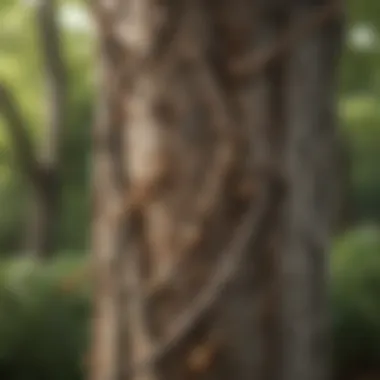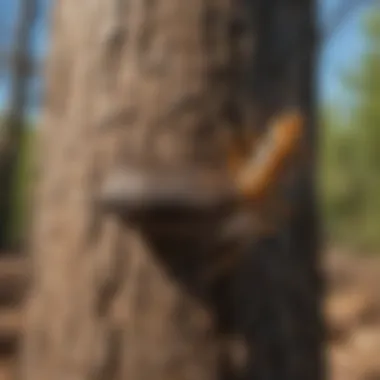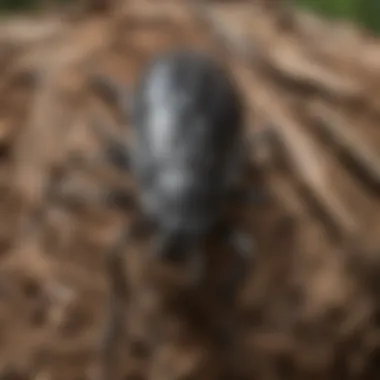Effective Methods for Treating Ash Trees Against Ash Borer Infestation


Overview of the Topic
When addressing the treatment of ash trees for ash borer infestation, it is crucial to understand the dire implications of this pervasive issue on the environment. Ash trees, integral components of forest ecosystems, are under siege by the destructive ash borer, risking ecological imbalance and biodiversity loss. This section delves into the significance of preserving ash trees and the urgency of implementing effective treatment strategies to combat ash borer infestation.
Current Status and Challenges
The current status of ash trees facing ash borer infestation presents a harrowing reality. As these voracious pests spread rapidly, ash tree populations are dwindling at an alarming rate, posing a severe threat to forest health. Challenges abound, including the difficulty of early detection, limited treatment options, and the potential for widespread deforestation. This section illuminates the grave challenges confronting ash trees and highlights the critical need for proactive solutions.
Sustainable Solutions
Amidst the bleak landscape of ash borer infestation, there exist sustainable practices and solutions that offer a glimmer of hope for ash tree preservation. By implementing integrated pest management techniques, utilizing biological controls, and promoting tree diversity, effective measures can be taken to mitigate the impact of ash borer infestation. Case studies showcasing successful resource management initiatives demonstrate the efficacy of sustainable solutions in safeguarding ash trees from further devastation.
Impact and Importance
The impact of ash borer infestation reverberates across ecosystems, communities, and future generations. Ecosystems suffer from disrupted nutrient cycles and diminished biodiversity, while communities grapple with the loss of valuable timber resources and aesthetic appeal. The importance of conservation efforts and sustainable resource use is paramount to ensure the survival of ash trees and the preservation of our natural heritage. This section delves into the far-reaching implications of ash borer infestation and underscores the critical importance of prioritizing conservation and restoration efforts.
Understanding Ash Borer Infestation
Understanding Ash Borer Infestation is crucial in combating the threat posed by these destructive insects towards ash trees. By delving into the intricacies of how the ash borers infest and harm the trees, one can develop effective strategies to mitigate their impact. This section aims to provide a comprehensive overview of the infestation process, its implications, and the importance of prompt detection and treatment.
Introduction to Ash Borer
Overview of Emerald Ash Borer
In the realm of ash borer infestations, the Overview of Emerald Ash Borer stands out as a prominent factor to consider. This particular species of borer is known for its devastating effects on ash trees, making it a significant focus in strategies for tree protection. Understanding the behavior and characteristics of the Emerald Ash Borer is vital for implementing targeted treatment and preventative measures. While its efficiency in attacking ash trees is notable, it also necessitates specialized attention due to its resilience and widespread impact.
Impact of Ash Borer on Ash Trees
The Impact of Ash Borer on Ash Trees showcases the repercussions of infestations, emphasizing the urgency in addressing this issue. Ash borers can lead to significant damage, compromising the health and stability of ash trees. Recognizing the symptoms and consequences of such infestations is essential for creating resilient tree management plans. By highlighting the interplay between ash borers and tree health, this section underscores the need for proactive measures to safeguard ash tree populations.
Signs of Infestation
Bark Splitting


Bark Splitting serves as a visible indicator of ash borer infestation, signaling potential harm to the tree's inner layers. This symptom, characterized by fissures in the tree's bark, reflects the underlying stress caused by borer activity. While easily noticeable, bark splitting warrants immediate attention to prevent further structural damage. Understanding the causes and implications of this sign is pivotal for early detection and intervention, enhancing the tree's chances of recovery.
Canopy Thinning
The phenomenon of Canopy Thinning signifies a gradual decline in the upper foliage density of ash trees, indicative of systemic stress. This symptom, although subtle initially, requires thorough assessment to discern its association with borer infestations. By elucidating the connection between canopy thinning and insect activity, arborists can formulate targeted treatment plans to preserve the tree's vitality. Vigilance in monitoring and addressing canopy thinning is instrumental in preventing irreversible damage.
D-shaped Exit Holes
D-shaped Exit Holes represent a distinctive hallmark of ash borer infestations, stemming from the insects' emergence from the tree post-infestation. The presence of these characteristic exit holes signifies active borer populations within the tree, necessitating immediate intervention. Recognizing the significance of these exit holes in gauging infestation severity aids in devising timely treatment strategies. By examining the location and density of exit holes, arborists can gauge the extent of borer activity and tailor their responses accordingly.
Ash Tree Vulnerability
Factors Contributing to Vulnerability
Factors Contributing to Vulnerability encompass a diverse range of influences that increase ash trees' susceptibility to borer attacks. From environmental stressors to tree health conditions, various factors can predispose ash species to infestations. Understanding the contributing elements sharpens one's ability to fortify trees against potential threats, promoting resilience and longevity. By addressing and mitigating these vulnerability factors, arborists can bolster the trees' natural defenses and diminish their attractiveness to borers.
Commonly Affected Ash Species
Commonly Affected Ash Species delineate the specific varieties most prone to borer infestations, shedding light on prevalent vulnerabilities within ash populations. Different ash species exhibit varying degrees of susceptibility to borer attacks, necessitating tailored management strategies. Recognizing the patterns of infestation among commonly affected species facilitates targeted monitoring and treatment efforts. By prioritizing the protection of these vulnerable ash species, conservationists and arborists can safeguard diverse tree populations and mitigate the impact of borer infestations.
Early Detection and Monitoring
Scouting for Ash Borer
Visual Inspections:
Visual inspections are a fundamental aspect of scouting for ash borers. This method involves visually examining the bark, leaves, branches, and overall health of ash trees to identify any signs of infestation. Visual inspections provide a direct and immediate way to detect early symptoms of ash borer activity, such as bark damage, larval galleries, or exit holes. Their practicality and efficiency make them a popular choice in this article, offering a firsthand look at the tree's condition. While visual inspections are cost-effective and non-invasive, they may have limitations in detecting hidden infestations or early stages of damage.
Use of Traps:
The utilization of traps is another valuable tool in scouting for ash borers. Traps are designed to attract and capture adult ash borers, aiding in monitoring their presence and population density. This method serves as a proactive approach to assess borer activity in a targeted manner. Traps offer a discreet yet effective means of surveying the insect population within a specific area, providing essential data for decision-making. While traps are efficient in monitoring adult ash borers, they may have certain drawbacks such as variability in attractant efficacy or limitations in capturing all borer individuals.
Symptom Identification
Yellowing Leaves:


Yellowing leaves are a significant symptom indicating ash borer infestation. This distinct discoloration of the foliage is often an early sign of stress or damage caused by borer larvae feeding on the tree's vascular system. The presence of yellowing leaves alerts observers to potential infestation threats, prompting further investigation and intervention. The characteristic yellow coloration stands out against the tree's natural greenery, serving as a visual cue for assessing its health. While yellowing leaves provide a clear visual indicator of potential issues, they may also be influenced by other environmental factors, necessitating a comprehensive assessment.
Epicormic Shoots:
The emergence of epicormic shoots is another symptom associated with ash borer infestation. These new growths sprout along the tree's stems or branches as a response to stress or damage caused by borer activity. Epicormic shoots represent the tree's attempt to regenerate and compensate for lost foliage, indicating a compromised vascular system. The presence of these shoots signals ongoing borer damage and the need for immediate attention. While epicormic shoots demonstrate the tree's resilience, excessive growth can impact its overall structural integrity, requiring careful monitoring and management.
Monitoring Techniques
Tree Inventory:
Tree inventory is a systematic method of assessing and cataloging ash trees within a designated area. Conducting a comprehensive tree inventory offers valuable insights into the distribution, health, and density of ash tree populations. This technique enables conservationists to prioritize monitoring efforts, identify high-risk areas, and track changes over time. By maintaining a detailed tree inventory, stakeholders can establish baseline data for monitoring and comparing infestation levels, facilitating informed decision-making. While tree inventory provides essential data for management purposes, it requires regular updates and may be resource-intensive.
Population Surveys:
Population surveys involve collecting data on the abundance and distribution of ash borers within a given area. These surveys employ various sampling techniques to estimate borer populations and assess infestation levels in different locations. By conducting population surveys, researchers can enhance their understanding of borer dynamics, movement patterns, and potential threats to ash trees. This method plays a crucial role in monitoring borer populations over time, identifying trends, and evaluating the effectiveness of control strategies. While population surveys offer valuable insights into borer dynamics, they necessitate careful planning, standardized protocols, and significant time and effort.
Preventive Measures
To truly safeguard ash trees from the devastating effects of ash borer infestation, preventive measures play a fundamental role. By implementing effective preventive strategies, we can proactively protect these valuable trees from the invasive pest. One key element of preventive measures is proper tree care, which involves regular pruning, adequate watering, and maintenance of overall tree health. Proper tree care not only enhances the tree's resistance to potential threats like ash borers but also promotes the tree's vitality and longevity. Another crucial aspect of preventive measures is mulching techniques, which help conserve soil moisture, regulate soil temperature, and inhibit weed growth around the tree base. Proper mulching can create a conducive environment for the tree's root system, enhancing its ability to withstand stressors such as pest infestations.
Cultural Practices
Proper Tree Care
Proper tree care is paramount in maintaining the health and vigor of ash trees. It involves techniques such as pruning dead or damaged branches, ensuring adequate watering, and monitoring for signs of pests or diseases. By implementing proper tree care measures, one can promote tree strength and resilience, enabling the tree to better combat potential threats like ash borer infestation. The key characteristic of proper tree care is its proactive approach in addressing tree health, focusing on prevention rather than reactionary measures. This approach not only benefits the specific tree in question but also contributes to overall ecosystem health by maintaining tree diversity and vitality.
Mulching Techniques
Mulching techniques offer numerous benefits in the context of ash borer infestation prevention. Proper mulching helps in moisture retention, weed suppression, and soil insulation, creating an optimal growth environment for ash trees. The key benefit of mulching techniques is their ability to enhance soil quality and minimize stress on trees, thereby fortifying them against potential threats like pest infestations. Utilizing mulch also aids in minimizing competition from surrounding vegetation, allowing the tree to allocate more resources towards growth and defense mechanisms. However, improper mulching practices can lead to excess moisture retention, root suffocation, or pest harborages, underscoring the importance of applying mulch correctly and in moderation.
Chemical Treatments
Chemical treatments offer an effective means of combating ash borer infestations, providing targeted solutions to mitigate pest populations and protect tree health. Insecticidal options represent a common choice for addressing ash borer infestations, delivering precise application of insecticides to control pest growth. The key characteristic of insecticidal options is their ability to specifically target ash borers while minimizing impacts on non-target organisms, thereby reducing ecological repercussions. However, reliance on chemical treatments necessitates vigilance in application and adherence to safety guidelines to prevent unintended consequences. One prevalent method of chemical treatment is systemic injections, involving the injection of insecticides directly into the tree's vascular system for distribution throughout the tree. Systemic injections offer long-lasting protection against ash borers by enabling the tree to uptake and circulate the insecticide, thereby deterring pest activity and minimizing damage.
Biological Control


Introduction of Natural Predators
Introducing natural predators serves as an eco-friendly approach to managing ash borer infestations, harnessing the predatory behavior of beneficial insects to control pest populations. The key characteristic of introducing natural predators is the establishment of a sustainable, self-regulating pest control system within the ecosystem. By encouraging natural predators like predatory beetles or parasitic wasps, one can effectively reduce ash borer populations while preserving ecological balance. This method offers a non-invasive and chemical-free solution to pest management, aligning with principles of integrated pest management and environmental conservation.
Use of Parasitic Wasps
Utilizing parasitic wasps presents another biocontrol strategy for combating ash borer infestations, leveraging the parasitic nature of certain wasp species to target and control pest populations. The key advantage of using parasitic wasps lies in their ability to specifically target ash borers while minimizing harm to beneficial insects and other wildlife. Furthermore, parasitic wasps offer a sustainable pest control solution that supports biodiversity and ecosystem resilience. However, deploying parasitic wasps for biocontrol necessitates a comprehensive understanding of their behavior and ecological impacts to ensure their effective integration into pest management strategies.
Treatment Strategies
Treating ash trees for ash borer infestation is crucial for preserving their health and longevity. In this section, we will delve into various treatment strategies that can effectively combat this threat. Understanding the specific elements, benefits, and considerations of these strategies is essential to safeguarding ash trees. By implementing the right treatment approach, we can mitigate the devastating effects of ash borer infestation and ensure the well-being of these trees for years to come.
Professional Intervention
Consulting Arborists
Consulting arborists play a pivotal role in addressing ash borer infestation. Their expertise in diagnosing tree issues and recommending suitable treatment plans is invaluable. Consulting arborists are known for their meticulous approach to assessing tree health and devising strategic interventions. Their ability to identify early signs of infestation and provide tailored solutions is why they are a preferred choice in combating ash borer threats. Despite their expertise, consulting arborists may come with a higher cost, but the invaluable insights and tailored treatments they offer make them a worthy investment.
Injection Services
Injection services are an effective method for treating ash trees infested with borers. This treatment involves injecting insecticides directly into the tree, targeting the pests at their core. The key characteristic of injection services is their targeted approach, delivering treatment precisely where it is needed most. This method is popular due to its efficiency and ability to minimize environmental impact compared to surface applications. While injection services can be costlier than some alternatives, their direct and lasting impact on borer infestation makes them a highly beneficial choice for ensuring the health of ash trees.
DIY Treatment Options
Soil Drenching
Soil drenching is a DIY treatment option that can help combat ash borer infestation. This method involves applying insecticides to the soil around the base of the tree, allowing the roots to absorb the treatment and deter borers. The key characteristic of soil drenching is its accessibility to homeowners and gardeners, offering a hands-on approach to tree care. While soil drenching may require repeated applications and time to take effect, its cost-effectiveness and relative ease of application make it a popular choice for DIY enthusiasts.
Foliar Sprays
Foliar sprays are another DIY treatment option for addressing ash borer infestation. By spraying insecticides directly onto the tree's foliage, this method targets borers feeding on leaves and branches. The key characteristic of foliar sprays is their versatility and quick application, reaching pests in hard-to-reach areas. While foliar sprays may require regular monitoring and application for optimal results, their immediate impact and ease of use make them a convenient choice for DIY tree care.
Long-Term Management
Tree Health Monitoring
Regular monitoring of tree health is essential for long-term management of ash borer infestation. By routinely assessing tree condition and detecting early signs of infestation, proactive measures can be taken to protect the tree's health. The key characteristic of tree health monitoring is its preventive nature, allowing for timely interventions to mitigate borer damage. While consistent monitoring requires time and effort, the benefits of early detection and targeted treatments far outweigh the challenges, making it a crucial aspect of ensuring the sustainability of ash trees.
Post-Treatment Care
Post-treatment care is vital for optimizing the effectiveness of treatment strategies and maintaining tree health post-infestation. This phase involves monitoring the tree's response to treatment, ensuring proper recovery, and implementing additional measures if needed. The key characteristic of post-treatment care is its focus on rehabilitation and future protection, enhancing the tree's resilience against future infestations. While post-treatment care demands ongoing attention and resources, the long-term benefits of preserving ash trees and preventing reinfestation make it a critical component of holistic tree care.



